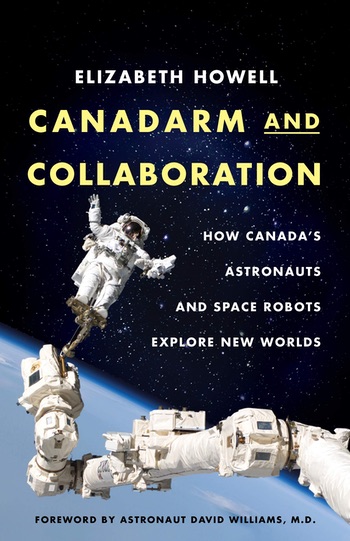Review: Canadarm and Collaborationby Jeff Foust
|
| Those robotic arms are “Canada’s space currency,” Howell writes, enabling cooperation with the United States in human spaceflight. |
The book is less about Canadarm and its successors—their technical development gets only a handful of pages in the book—but instead how they enabled Canadian human spaceflight efforts. The original agreement with NASA in the 1970s to develop Canadarm opened the door for Canadian astronauts to fly on the shuttle, starting with Marc Garneau in 1984. Those flight opportunities have waxed and waned over the decades, including a “golden age” in the latter half of the 1990s when Canadians flew about once a year. Those flight opportunities are now much less frequent: as the smallest partner on the International Space Station, it gets only one seat every few years.
Howell intertwines the stories of Canadian astronauts who flew with policy issues. Winning sustained support, and funding, for spaceflight long has been a challenge in the country. In the early 1990s, Canada came close to pulling out of the ISS program, citing budget problems; only a last-minute phone call from President Bill Clinton convinced Canadian Prime Minister Jean Chrétien to stay in the program. More recently, Canada’s space industry struggled to get the government to commit to a long-term space strategy, and ran ads on buses in Ottawa with the slogan “Don’t Let Go Canada.” Interestingly, while space struggled for political support, former astronauts have found political success: Garneau is the country’s transportation minister while Julie Payette is governor general, the Queen’s official representative in Canada.
Canada is not letting go, it appears. In early 2019 the government announced it would participate in NASA’s lunar Gateway through—what else?—a robotic arm called Canadarm3. (Howell notes in the book that the announcement featured Prime Minister Justin Trudeau, even as his government was in the midst of a political scandal, leading some to speculate the announcement was a diversion.) Although NASA revised its lunar exploration plans just a month later, reducing the initial emphasis on the Gateway, Canada remains committed to the Canadarm3, planning to spend about US$1.5 billion on the effort over two decades.
Canadarm and Collaboration is not a detailed history of Canadian space efforts: there’s not much about, for example, the Radarsat series of spacecraft that made Canada a world leader in synthetic aperture radar Earth observation. It does, though, illustrate how the country has maintained a human spaceflight program for several decades through a combination of technological specialization—Canadarm and its successors—and collaboration with the United States. With Canadarm3 and the Gateway, that effort will continue well into the next decade, but whether, and how, it can grow remains to be seen.
Note: we are temporarily moderating all comments submitted to deal with a surge in spam.
